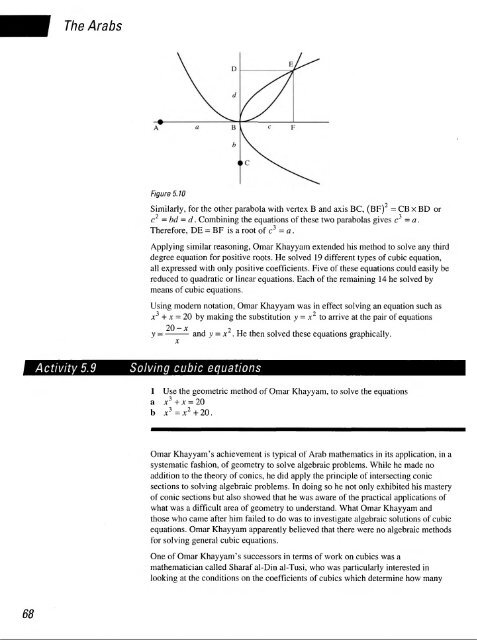history of mathematics - National STEM Centre
history of mathematics - National STEM Centre
history of mathematics - National STEM Centre
You also want an ePaper? Increase the reach of your titles
YUMPU automatically turns print PDFs into web optimized ePapers that Google loves.
68<br />
The Arabs<br />
Figure 5.10<br />
Activity 5.9 Solving cubic equations<br />
Similarly, for the other parabola with vertex B and axis BC, (BF) = CB x BD or<br />
c2 = bd = d. Combining the equations <strong>of</strong> these two parabolas gives c3 = a.<br />
Therefore, DE = BF is a root <strong>of</strong> c 3 = a.<br />
Applying similar reasoning, Omar Khayyam extended his method to solve any third<br />
degree equation for positive roots. He solved 19 different types <strong>of</strong> cubic equation,<br />
all expressed with only positive coefficients. Five <strong>of</strong> these equations could easily be<br />
reduced to quadratic or linear equations. Each <strong>of</strong> the remaining 14 he solved by<br />
means <strong>of</strong> cubic equations.<br />
Using modern notation, Omar Khayyam was in effect solving an equation such as<br />
x 3 + x = 20 by making the substitution y = x2 to arrive at the pair <strong>of</strong> equations<br />
y = ——— and y = x2 . He then solved these equations graphically.<br />
1 Use the geometric method <strong>of</strong> Omar Khayyam, to solve the equations<br />
a ;t 3 + x = 20<br />
b x 3 =i'<br />
Omar Khayyam's achievement is typical <strong>of</strong> Arab <strong>mathematics</strong> in its application, in a<br />
systematic fashion, <strong>of</strong> geometry to solve algebraic problems. While he made no<br />
addition to the theory <strong>of</strong> conies, he did apply the principle <strong>of</strong> intersecting conic<br />
sections to solving algebraic problems. In doing so he not only exhibited his mastery<br />
<strong>of</strong> conic sections but also showed that he was aware <strong>of</strong> the practical applications <strong>of</strong><br />
what was a difficult area <strong>of</strong> geometry to understand. What Omar Khayyam and<br />
those who came after him failed to do was to investigate algebraic solutions <strong>of</strong> cubic<br />
equations. Omar Khayyam apparently believed that there were no algebraic methods<br />
for solving general cubic equations.<br />
One <strong>of</strong> Omar Khayyam's successors in terms <strong>of</strong> work on cubics was a<br />
mathematician called Sharaf al-Din al-Tusi, who was particularly interested in<br />
looking at the conditions on the coefficients <strong>of</strong> cubics which determine how many
















